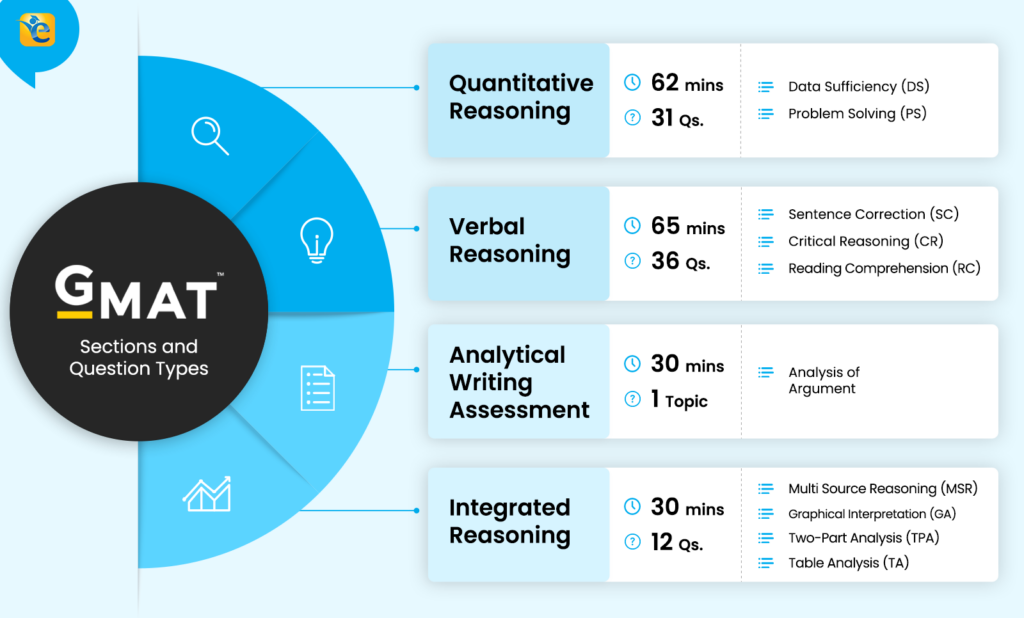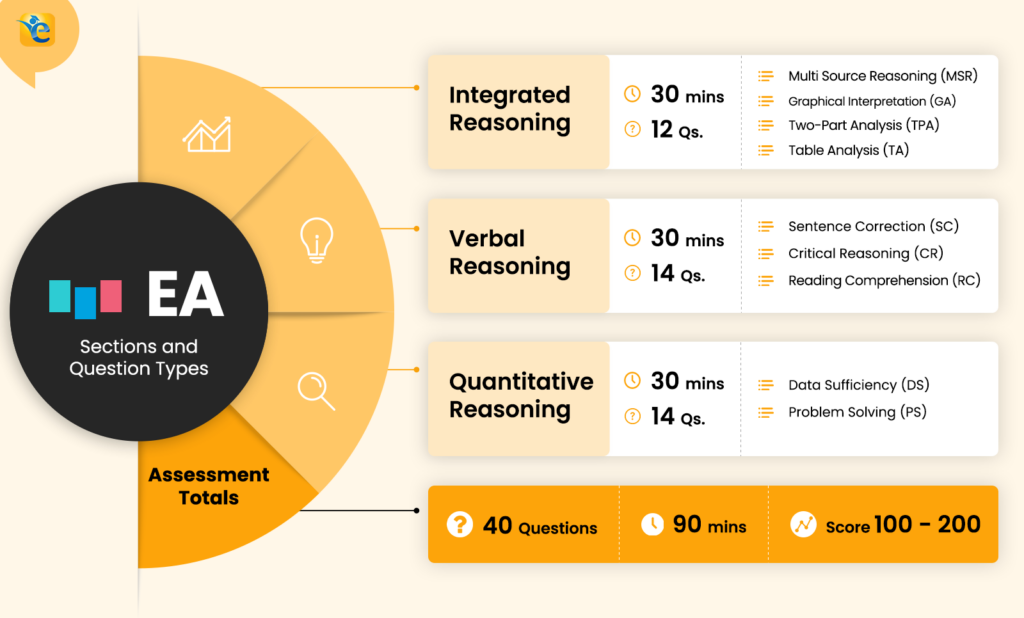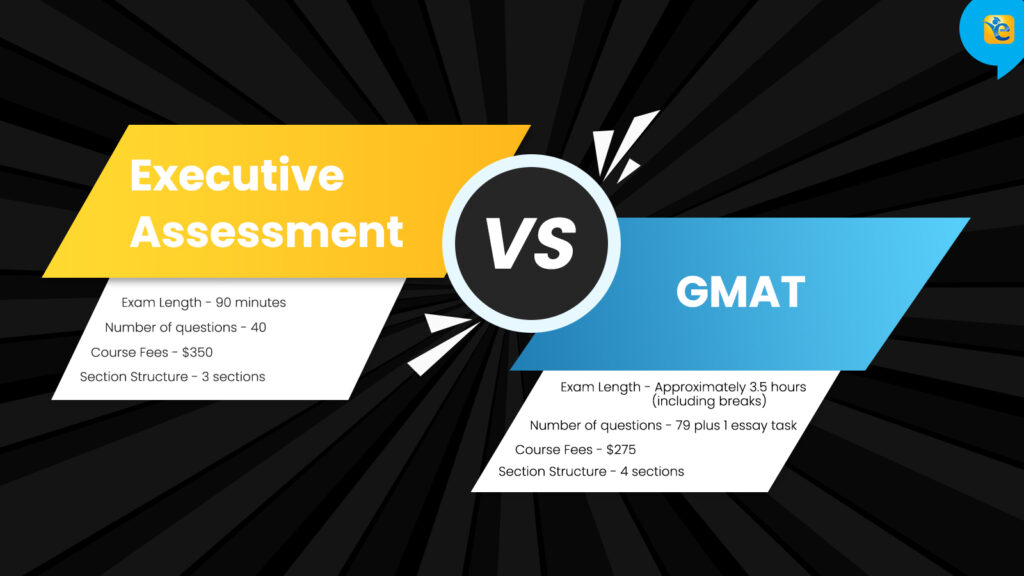Introduction: Executive Assessment vs GMAT
In the realm of MBA admissions, standardized tests play a pivotal role in evaluating candidates’ suitability for graduate-level business education. These tests serve as a benchmark to assess critical skills required for success in the business world. Two prominent tests in this domain are the Executive Assessment (EA) and the GMAT (Graduate Management Admission Test). This article provides a concise overview of the importance of standardized tests in MBA admissions and focuses on highlighting the key differences between the Executive Assessment and the GMAT.
By gaining insights into the nuances of the Executive Assessment and the GMAT, prospective MBA candidates can navigate the testing landscape more effectively and select the test that aligns with their skills, preferences, and career goals.
In the realm of MBA admissions, standardized tests play a pivotal role in evaluating candidates’ suitability for graduate-level business education. These tests serve as a benchmark to assess critical skills required for success in the business world. Two prominent tests in this domain are the Executive Assessment (EA) and the GMAT (Graduate Management Admission Test). This article provides a concise overview of the importance of standardized tests in MBA admissions and focuses on highlighting the key differences between the Executive Assessment and the GMAT.
By gaining insights into the nuances of the Executive Assessment and the GMAT, prospective MBA candidates can navigate the testing landscape more effectively and select the test that aligns with their skills, preferences, and career goals.
In the realm of MBA admissions, standardized tests play a pivotal role in evaluating candidates’ suitability for graduate-level business education. These tests serve as a benchmark to assess critical skills required for success in the business world. Two prominent tests in this domain are the Executive Assessment (EA) and the GMAT (Graduate Management Admission Test). This article provides a concise overview of the importance of standardized tests in MBA admissions and focuses on highlighting the key differences between the Executive Assessment and the GMAT.
By gaining insights into the nuances of the Executive Assessment and the GMAT, prospective MBA candidates can navigate the testing landscape more effectively and select the test that aligns with their skills, preferences, and career goals.
In the subsequent sections, we will delve into the structures, scoring methodologies, question formats, and content coverage of both the Executive Assessment and the GMAT. We will discuss the advantages and disadvantages of each test, considering factors such as their impact on program rankings, test anxiety considerations, convenience, and acceptance by MBA programs. We hope this will aid you in making a well-informed decision for your MBA journey!
What is the GMAT?
The GMAT, or Graduate Management Admission Test, is a widely accepted standardized exam for individuals applying to graduate business programs like MBA. Developed and administered by the Graduate Management Admission Council (GMAC), the GMAT has been recognized by universities and business schools worldwide for over 60 years. While other exams like the GRE are also accepted, the GMAT remains the more commonly taken test for business school admission, with approximately 200,000 test takers each year. Its purpose is to assess the readiness and aptitude of candidates for advanced business studies.
Case Study: James, a Full-Time MBA Applicant
James, a financial analyst, has been working in a renowned investment bank for the last four years. During this time, he managed to garner significant experiences in financial modeling, investment strategies, and client relationship management. Although he has built a solid career in finance, he aspires to broaden his business acumen and leadership skills to transition into a strategic role within his firm, and possibly, in the future, venture into his own start-up.
Given his career aspirations, James decided to pursue a Full-Time MBA program. He believes that an MBA will provide him with a comprehensive understanding of various aspects of business, including strategy, marketing, operations, and entrepreneurship, enabling him to successfully accomplish his career goals.
After considering his options, he decided to take the GMAT. There were several reasons for this:
- Relevance of Full-Time MBA Program: Most full-time MBA programs, including the ones James was particularly interested in, predominantly preferred the GMAT. These schools valued the comprehensive skill evaluation that the GMAT offers, including analytical writing, integrated reasoning, quantitative reasoning, and verbal reasoning.
- Alignment with Career Goals: James’s goal to move into a strategic leadership role necessitates a strong understanding of diverse business areas and the ability to make decisions using a broad business perspective. The GMAT’s comprehensive structure and its focus on various aspects of reasoning and analytical writing align well with his career aspirations.
- Showcasing his academic prowess: Given his strong quantitative and verbal skills, honed during his years as a financial analyst and his undergraduate degree in Economics, James felt that the GMAT would be a better platform to showcase these skills to the admission committees.
- Professional Experience: While James had significant professional experience, he didn’t quite meet the target profile for the EA, which is primarily designed for senior professionals with substantial managerial experience looking to enter executive MBA programs.
- Preparation Time: James was in a position to dedicate a considerable amount of time each week to prepare for the GMAT. He planned his study schedule carefully, ensuring he could cover all the sections of the GMAT thoroughly.
By choosing the GMAT, James aimed to present a strong application reflecting his quantitative aptitude, verbal skills, and readiness for a rigorous full-time MBA program. His decision was not merely guided by his preference but was a strategic move aligning with his career goals and the expectations of his target MBA programs.
Overview of Sections and Question Types in the GMAT
The GMAT consists of four main sections: Analytical Writing Assessment (AWA), Integrated Reasoning (IR), Quantitative Reasoning, and Verbal Reasoning. Each section evaluates different skills and abilities, providing a comprehensive assessment of an applicant’s aptitude for business studies.

- Section 1 – AWA – “The Analytical Writing Assessment (AWA) measures your ability to think critically and to communicate your ideas. During the AWA, you are asked to analyze the reasoning behind a given argument and write a critique of that argument”.
- Duration: 30 minutes
- Analysis of Argument for 1 Topic
- Section 2 – IR – “The Integrated Reasoning section of the GMAT measures your ability to evaluate information presented in multiple formats from multiple sources – skills you need to succeed in our technologically advanced, data-driven world.”
- Duration: 30 minutes
- 12 Questions of the following question types:
- Multi-Source Reasoning
- Graphics Interpretation
- Two-Part Analysis
- Table Analysis
- Section 3 – Quant – “The Quantitative section measures your ability to analyze data and draw conclusions using reasoning skills. The mathematics needed to understand and solve the questions in this section of the GMAT exam is no greater than what is generally taught in secondary school classes.”
- Duration: 62 minutes
- 31 Questions of the following question types:
- Problem Solving (PS)
- Data Sufficiency (DS)
- Section 4 – Verbal – “The Verbal section measures your ability to read and understand written material, to evaluate arguments, and to correct written material to conform to standard written English.”
- Duration: 65 minutes
- 36 Questions from the following topics:
- Reading Comprehension (RC)
- Critical Reasoning (CR)
- Sentence Correction (SC)
Each section of the GMAT contains different question types, such as multiple-choice, multi-select, and data sufficiency. These question formats aim to assess various aspects of a candidate’s knowledge, analytical thinking, problem-solving abilities, and communication skills.
In the following sections, we will explore the key differences between the GMAT and the Executive Assessment (EA), providing insights into their unique features and helping you make an informed decision about which test to choose for your MBA admissions journey.
What is the Executive Assessment (EA)?
The Executive Assessment (EA) is a standardized test designed specifically for individuals seeking admission to executive MBA (EMBA) programs or other specialized business master’s programs. Developed by the Graduate Management Admission Council (GMAC), the same organization responsible for the GMAT, the EA is tailored to assess the skills and capabilities of experienced professionals who are looking to advance their careers in executive-level positions.
Overview of the sections and question types in the EA
The EA consists of three main sections: Integrated Reasoning, Verbal Reasoning, and Quantitative Reasoning. Each section is designed to evaluate specific skills and abilities relevant to executive-level decision-making.

- Integrated Reasoning: This section assesses a test taker’s ability to analyze complex information from various sources and draw meaningful conclusions. The questions in this section require candidates to interpret data presented in charts, graphs, and tables, evaluate multiple sources of information, and make informed judgments.
- Duration: 30 minutes
- 12 Questions of the following question types:
- Multi-Source Reasoning
- Graphics Interpretation
- Two-Part Analysis
- Table Analysis
- Verbal Reasoning: The Verbal Reasoning section measures a candidate’s ability to comprehend and evaluate written material. It includes questions that assess reading comprehension, critical reasoning, and sentence correction. Test takers are expected to understand and analyze written passages, identify logical relationships, and apply effective reasoning skills.
- Duration: 30 minutes
- 14 Questions from the following topics:
- Reading Comprehension (RC)
- Critical Reasoning (CR)
- Sentence Correction (SC)
- Quantitative Reasoning: The Quantitative Reasoning section evaluates a test taker’s mathematical and analytical skills. It includes questions covering arithmetic, algebra, geometry, and data analysis. Candidates are required to solve quantitative problems, interpret data presented in various formats, and apply mathematical concepts to real-world scenarios.
- Duration: 30 minutes
- 14 Questions of the following question types:
- Problem-Solving (PS)
- Data Sufficiency (DS)
Comparison of the Executive Assessment to the GMAT in terms of the target audience
While both the EA and GMAT are standardized tests used in MBA admissions, they differ in terms of the target audience they cater to.
The GMAT is widely taken by individuals who are pursuing traditional full-time MBA programs or other general business master’s programs. It is designed to assess a broad range of skills across multiple sections, including analytical writing, integrated reasoning, quantitative reasoning, and verbal reasoning. The GMAT is suitable for individuals at different stages of their academic and professional journeys, from recent college graduates to mid-career professionals.
On the other hand, the EA is specifically tailored for experienced professionals seeking admission to executive MBA (EMBA) programs or specialized business master’s programs. It focuses on assessing skills that are most relevant to executive-level decision-making. The EA recognizes the unique experiences and expertise of these professionals and provides a more streamlined assessment that aligns with their career goals and aspirations.
Case Study: Linda, an Executive MBA Applicant
Linda has had a successful career spanning over a decade in operations management within the manufacturing industry. With an undergraduate degree in Mechanical Engineering and a master’s degree in Industrial Engineering, Linda gradually climbed the corporate ladder to become an operations director in her current firm. However, she aspires to broaden her scope beyond operations and aim for a top executive role within her organization, overseeing not just operations but also strategy, finance, and marketing.
Recognizing that she needs a holistic understanding of business to make this leap, Linda decided to pursue an Executive MBA (EMBA) program. She believed an EMBA, designed for experienced professionals with leadership potential, would help her acquire the broad business knowledge and strategic mindset she sought.
After weighing her options, Linda decided to take the EA for the following reasons:
- Alignment with EMBA Programs: EMBA programs typically prefer the EA as it is specifically designed to assess the aptitude of experienced professionals aspiring for leadership roles. Most of the EMBA programs Linda was interested in either required or accepted EA scores.
- Experience Relevance: With over ten years of professional experience, Linda was the target demographic for the EA. The EA’s design recognizes the vast experiences that such seasoned professionals bring and focuses on assessing higher-order thinking rather than basic academic abilities.
- Time Considerations: As an operations director, Linda had a busy schedule, and she found the shorter preparation time and the test duration of the EA more suitable. Moreover, she appreciated that the EA does not require extensive preparation in areas she had not touched upon for years.
- Reflecting her Skills: Linda believed that the EA would better reflect her skill set. As a director, her job involved complex decision-making, often requiring the integration of information from various sources – skills the EA particularly focuses on.
- Career Aspirations: Linda’s goal is to move into a broader, more strategic role. The EA aligns well with this objective as it tests skills critical for executive roles, such as integrated reasoning and data analysis.
By opting for the EA, Linda hoped to present a compelling case to her target EMBA programs demonstrating her readiness for advanced business leadership roles. The decision was well-aligned with her career goals, work schedule, professional experience, and the requirements of her target EMBA programs.
Key differences between the GMAT and Executive Assessment

When comparing the GMAT and Executive Assessment (EA), there are several key differences to consider. These differences encompass various aspects, including scoring and score reporting, their role in MBA program rankings, test structure, sections, question types, and content coverage.
In simple terms, the Executive Assessment (EA) can be considered a shorter and more focused version of the GMAT. The EA is designed for busy professionals with management-level business skills, while the GMAT is more comprehensive and suited for a wider range of test-takers.
Here’s a table summarizing the key differences between the GMAT and Executive Assessment:
| Aspect | Executive Assessment (EA) | GMAT | GMAT Focus Edition |
| Exam Length | 90 minutes | Approximately 3.5 hours (including breaks) | 2 hours 15 minutes |
| Number of Questions | 40 | 79 plus 1 essay task | 64 |
| Breaks | No breaks permitted | Two optional 8-minute breaks | Two optional 8-minute breaks |
| Section Order | Fixed order: Integrated Reasoning, Verbal Reasoning, Quantitative Reasoning | Choose from three different section orders | Any order is possible |
| Section Structure | 3 sections divided into 6 modules | 4 sections | 3 sections |
| Question Review | Can review, edit, skip, and return to questions | Cannot review or change answers once submitted | Can review, edit, skip, and return to questions up to three times per section |
| Computer Adaptivity | Adaptive at the module level within Quant and Verbal sections | Adaptive at the question level within Quant and Verbal sections | Adaptive at the question level within Quant and Verbal sections |
| Content Differences | Tests fewer Quant topics, omits advanced Quant topics (e.g., geometry), similar content in Verbal and IR sections | Tests broader range of Quant topics, includes geometry questions | Removes Sentence Correction from Verbal section, omits Geometry from Quant section, introduces Data Insights section |
| Scoring | Quant, Verbal, and IR scores all contribute equally to the total score | Total score based on Quant and Verbal performance; IR and AWA scores do not count | Total score based on performance in all three sections |
| Cost | $350 | $275 | TBA |
| Retake Policy | Up to 2 attempts at a test center, 2 attempts online (considered separately) | No limit on test center attempts, online retake policy varies | TBA |
| Waiting Period | Can register for a retake as soon as 24 hours after the first attempt | No specific waiting period, can retake as desired | TBA |
Let’s delve into each of these differences:
1. Comparison of Scoring and Score Reporting:
The GMAT uses a 200-800 scoring scale, while the EA uses a score range from 0 to 200. Additionally, the GMAT provides a separate Analytical Writing Assessment (AWA) score, which is not included in the EA. Furthermore, the GMAT offers an option to cancel scores, while the EA does not provide a score cancellation feature.
- On the GMAT, only Quant and Verbal sections contribute to the total score, while on the EA, Quant, Verbal, and IR scores are equally weighted.
- Both exam scores are valid for five years from the test date.
2. Role in MBA Program Rankings:
The GMAT has historically played a significant role in MBA program rankings. Business schools often consider high GMAT scores as an indicator of a candidate’s ability to succeed in the program. These scores can also contribute to a school’s ranking and reputation. Conversely, the EA does not factor into MBA program rankings. MBA programs primarily look for a “good enough” EA score, focusing more on evaluating an applicant’s overall profile rather than solely relying on their EA performance.
3. Exam Structure and Format:
- The EA and GMAT have similar exam structures and formats, with both being computer-based multiple-choice exams.
- The EA is shorter, lasting 90 minutes with 40 questions, while the GMAT is over 3 hours long with 79 questions and an essay task.
- The EA does not include an Analytical Writing Assessment (essay task), which reduces its testing time.
- The EA does not allow any breaks during the exam, while the GMAT permits optional breaks.
4. Section Order:
- In the EA, the sections (Integrated Reasoning, Verbal Reasoning, and Quantitative Reasoning) always appear in the same order and cannot be changed.
- In the GMAT, test-takers can choose their section order from three options: Writing, IR, Quant, Verbal; Verbal, Quant, IR, Writing; Quant, Verbal, IR, Writing.
5. Section Structure:
- The EA has three sections with each section divided into two successive subsections or “modules,” while the GMAT has four sections.
- Each section of the EA is divided in half, but the time allocated is for completing both modules together.
- The EA allows test-takers to review and edit their work at the end of each module, while the GMAT does not allow for review or editing of previously answered questions.
6. Adaptivity:
- The GMAT is computer-adaptive at the question level, adjusting the difficulty based on previous responses, while the EA is adaptive at the module level, adjusting difficulty from one module to the next.
- The GMAT does not allow skipping or returning to questions, while the EA allows test-takers to skip and return to questions within each module.
7. Exam Content:
- The EA and GMAT test similar skills and knowledge needed for success in the business world.
- The Verbal and Integrated Reasoning sections have identical content on both exams.
- The EA tests fewer Quant topics compared to the GMAT and omits some advanced Quant topics like geometry. EA Quant focuses on arithmetic and freshman-level algebra.
8. Exam Cost:
- The registration fee for the EA is $350, while the GMAT registration fee is $275.
- The EA has more lenient rescheduling and cancellation policies, which may contribute to the higher cost.
9. Registration and Testing:
- Both exams can be registered and scheduled through the mba.com website.
- Test-takers can retake the EA up to two times at a test center and two times online.
- Online and test center attempts are considered separate for the EA.
- Test-takers can register for an in-person retake 24 hours after their first attempt and have multiple retake opportunities.
In summary, the EA is a shorter and more focused exam for busy professionals with management-level skills, while the GMAT is a comprehensive exam suitable for a wider range of test-takers. The EA has a different structure, content emphasis, and scoring system compared to the GMAT, but both exams aim to assess skills relevant to the business world.
Factors to Consider when Choosing between the GMAT and EA
When deciding between the GMAT (Graduate Management Admission Test) and Executive Assessment (EA) for MBA admissions, there are several factors that prospective applicants should consider. Understanding these factors can help individuals make an informed decision about which test to take based on their specific circumstances and goals.
1. Target MBA Programs and Their Requirements:
One of the first considerations when choosing between the GMAT and EA is the requirements of the MBA programs you are targeting. EA is preferred by EMBA aspirants typically, while full-time MBA aspirants prefer the GMAT. If you’re a seasoned working professional targeting an Executive MBA program, EA is the way to go for you!
2. Personal Strengths, Preferences, and Test-Taking Skills:
Another factor to consider is your personal strengths, preferences, and test-taking skills. The GMAT and EA have different formats and question types, and individuals may perform better on one test than the other based on their strengths and abilities. For example, the GMAT includes a broader range of question types, including quantitative, verbal, analytical writing, and integrated reasoning, while the EA focuses more on integrated reasoning and verbal skills. Consider which test aligns better with your strengths and preferences to maximize your performance.

Conclusion – Executive Assessment vs GMAT
In conclusion, the choice between the GMAT and EA for MBA admissions depends on several factors, including the requirements of your target MBA programs, personal strengths and preferences, and the importance of program rankings and score competitiveness. It is essential to research and understand the differences between the two tests to make an informed decision.
The GMAT is a comprehensive exam that covers a wide range of question types and is highly regarded by business schools. It may be suitable for individuals who excel in multiple areas and value program rankings.
On the other hand, the EA is designed specifically for executive MBA programs and focuses on integrated reasoning and verbal skills. It offers certain advantages such as a shorter test duration, flexibility in question review, and lower rescheduling fees.
Ultimately, the choice between the GMAT and EA should be based on your individual circumstances, goals, and the requirements of your target MBA programs. Consider your strengths, preferences, and the factors that are most important to you in the admissions process. By carefully evaluating these factors, you can select the test that aligns best with your abilities and maximizes your chances of success in pursuing an MBA.














